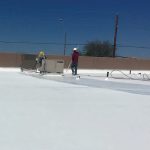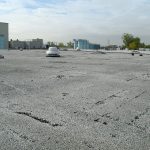Hurricane Stands Aren’t Just For Hurricanes
Hurricane stands are pretty standard in hurricane-prone areas such as Florida. In fact Florida Building Code requires that all rooftop equipment and supports shall be secured to the structure in compliance with the loading requirements of Chapter 16 (High-Velocity Hurricane Zones).
Now there’s been a few rouge hurricanes in the north these last few years but you may be asking yourself if you have a building in the north why would you be interested in installing hurricane stands on your roof.
Good question! But we have found that the use of rooftop hurricane stands has many benefits other than securing roof top units from high winds.

Typical Rooftop Unit Supports
Typically roof top units outside of hurricane zones are either set directly on the roof, on wooden supports called sleepers, or on other types of dunnage.
Using sleepers (e.g. wood blocking or concrete pavers) to support these types of mechanical units can have a negative impact on the long-term performance of the surrounding roof system. In addition, keeping units close to the roof deck by setting them on sleepers placed on the roof surface may negatively impact the performance of the units themselves.

4 Reasons You Should Install Hurricane Stands to Elevate Package Units Above Roof Deck

The installation of dunnage to support roof top equipment including small split units placed on the roof surface has significant benefits both for the roof system as well as the units themselves. These sets of dunnage can be retrofitted in existing roof systems or they may be installed as part of a roof replacement or installation project.





